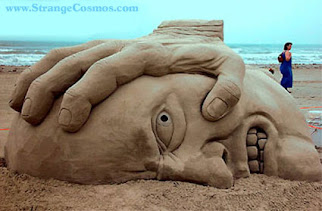Phulkari embroidery comes from the colorful state of Punjab in India. The phukari embroidery is known for its ellaborate embroidery work in multi colored threads all over the fabric. Originally this type of embroidery was seen in the traditional odnis or churnis worn by the punjabi women. Over the years this embroidery became heavy and more complex and the heavily embroidered odhinis came to be known as bagh (literally garden). All over embroidery work in Phulkari is not only on seen odhinis but also on saris, suits, bed covers and home furnishing in bright and vivid colours. Phulkari, literal meaning of which is flower-crafting, has become an important part of the trousseau in Punjab. The embroidery covers every inch of the entire base material so that the cloth is completely invisible.
 |
| Phulkari embroidery |
Fabric used in phulkari embroidery
The traditional fabric used was hand-spun, hand-woven and natural dyed khadi. Later on, other fabric varieties like cotton, silk were also used. The beauty of Phulkari depended a great deal on the colour of the ground material.
Threads Used in phulkari embroidery
The threads used was pure silk. Golden yellow, white, green, crimson red and orange are the five colours prepared in selecting silk floss for Phulkari work. The embroidery done with untwisted floss silk threads simulates the effect of brilliant, coloured flowers. Light falling on the glossy, single colour silk threads makes the embroidery appear multi-hued.
The technique used
The stitch Phulkari consists long short darning stitches. It is a unique method of embroidery. This is because it is stitched entirely on the wrong side of the cloth and the pattern takes shape on the right side. The design is neither drawn nor traced. Phulkari designs are guided only by the embroider’s skill and imagination, without any paper pattern or reference books.
 |
| Women folk working on phukari |
Motifs Used in phulkari embroidery
The motifs are made up of vertical, horizontal, and diagonal stitches, producing geometric or flowery pattern in Phulkari designs. The Baugh has an overall geometrically floral pattern. Common motifs included five stylised, eight-petalled lotuses, a flower that traditionally symbolises purity in India. The sanchi phulkari bears figural motifs like as scenes from everyday life. Another interesting phulkari design was the darshan dwar, embroidered on red cloth. These profusely embroidered textiles bear human figures standing at the shrine, along with other motifs, and are offered to the temple on the fulfilment of a vow. Occasionally, small pieces of mirrors are embroidered into the phulkari for a decorative look. Birds, especially the peacock, streams of water, flowers, the moon, and traditional Indian ornaments are popular motifs. Some motifs spring from the kitchen, which give the Phulkaris their names such as, Dhania (coriander) Bagh, Gobhi (cabbage) Bagh,Mirchi (chilli) Bagh, and Karela Bagh (bitter gourd) ! Names are also derived from the number of colours used. A Pancharanga is a five coloured Phulkari, while satranga is a seven-coloured one.
With ample potential for individual expression, each Phulkari reflects the women’s sense of aesthetics and expertise. Motifs are passed from mother to daughter and within families. The result of Phulkari embroidery is inevitably dazzling with bright, lustrous coloured threads shining. Many beautiful old Phulkaris and baghs continue to be passed down from one generation to another. Their beautiful and dense patterning convey the love, care and sheer effort that went into crafting them.
 |
| Phukari Suit |
 |
| Phulkari Duppata |





















